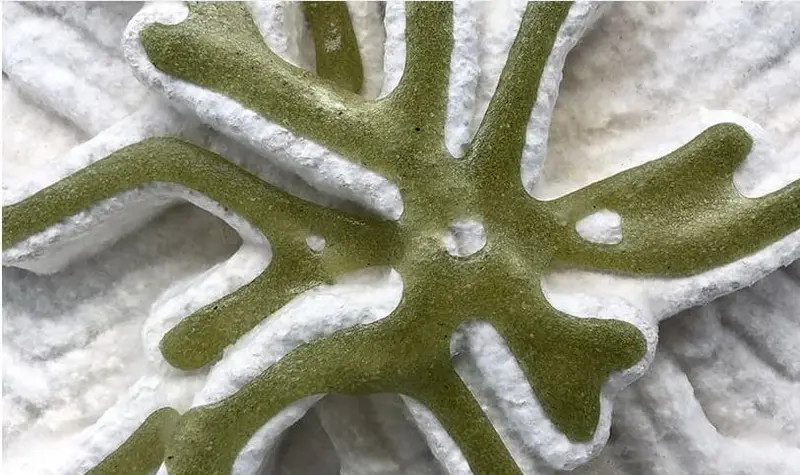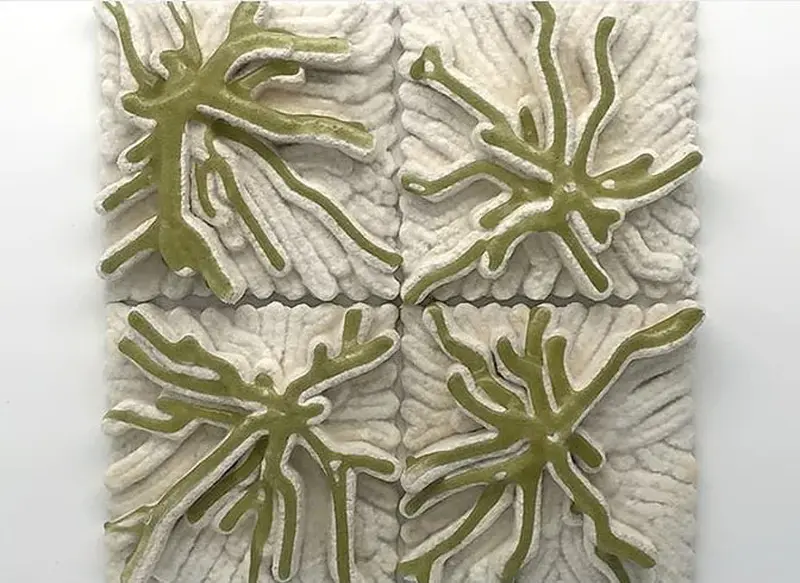This technology is a true leap into the future. The production of MYCO-ALGA tiles by bioMATTERS is only remotely associated with traditional building materials manufacturing.
It is developed in digital format, then printed on 3D printers From organic waste, mushroom mycelium, and algae, they cultivate and enrich with biopigments.
By producing tiles made from living cells and recycled natural waste, their developers guarantee 100% biodegradability of the final product.
The MYCO-ALGA tile has enriched the extensive portfolio of startups, which is filled with a variety of bio-digital products, including building materials and textiles. The inventors see them as an alternative to conventional materials, the production of which may be called into question in the era of global warming.
How tiles are modeled, printed, and grown.
Using computational algorithms, the company’s employees design tiles in digital form and then print them on a 3D printer. The product is grown and enriched with biopigments that give it natural shades.
If you take a closer look at the multi-stage cycle, you will first be interested in the author’s method of processing household and industrial waste, developed by specialists at bioMATTERS. In the process, the waste is crushed into a paste-like substrate. This serves as the basis for the growth of mycelium – a fungal network that resembles a tangle of threads. The mycelium-inoculated paste is printed on a 3D printer into separate shapes. Then, over the course of about two weeks, in a controlled climate environment, the mycelium paste grows and acts as a natural adhesive. The paste permeates the product and bonds it together, ultimately covering the entire surface.

To stop further growth, specialists place the tiles in convection ovens. As a result of drying and dehydration, a hard, durable, and simultaneously lightweight material is produced.
The final stage involves decorating the products with algal and mycelial biopigments in the form of gels. They are printed using a 3D printer onto each tile, the publication reported. Designboom .
Thanks to the creamy color of the mycelium and the light green hue of the algae, the ready biocomposite tiles make a beautiful decoration for interiors. The texture of the material is soft and velvety. Importantly, each tile is unique due to the endless variations in patterns. Additionally, it absorbs sound very well.
Wizards from bioMATTERS
The team of this research and design studio, founded in 2018, modestly refers to their work as “bio-digital craftsmanship.” They consider their mission to be the production of goods using innovative methods in the context of depleting natural resources.
The startup idea belongs to architect Nancy Diniz, who conducts research at the intersection of biological systems and computational design, as well as to Frank Melendez, an architectural designer and researcher.

In their studio-laboratory, they work with living cells extracted from mycelium, lichens, bacteria, and algae. The inventors have developed methods and protocols that allow for the reproduction of these cells, their colonization in substrates, and scaling in various biocomposite materials.
The team takes pride in its experience in developing bio-digital products, 3D printing, and robotic bio-manufacturing of materials with minimal waste. They consider their contributions to be extremely relevant in the context of depleting natural resources and the climate crisis.
